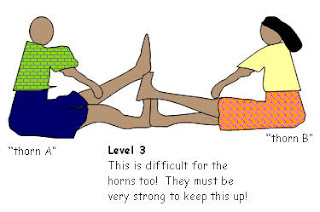To begin, create boxes that should look like this, numbered 1 to 10.

Then find a puck - could be a smooth stone or a rounded tile that you can use as your marker. Each player has their own individual markers or pucks. Nice stones, a smoothened terra cotta or piece from a broken pottery, it has to be heavy enough to stay when thrown but flat enough to get the right balance so you can throw it easily to where you want it to land (onto which box and/or number).
You begin with the puck at number one. If your puck is in box 1, you skip that box and jump to box number two using only one leg. You can only land with both feet in each box at numbers 4 and 5 and also on numbers 8 and 9. When you reach box ten, you can pivot so you can skip back down to box number 2, thne you pick up your puck by bending and keeping one leg up and jump out of the boxes on both feet.
Now you throw your puck and make sure it lands on box 2. Start with one foot in box 1, skip box 2 where your puck is, using the same leg, land your foot on box 3 and continue up to box 10. Pivot and go back down, at box 3, bend to pick up your puck on box 2, since box 2 is empty, you can now jump into it down to box 1 and out of the boxes.
Players take turns throwing their pucks starting at number 1. If you didn't throw your puck on the correct box, you miss your turn and will have a chance after all the other players have finished their turns.
What do you learn?
From this game, you learn the early counting, balance and how to aim for something using your hands, arms and fingers. You gauge the weight of your puck and throw it with just the right force. You learn to strengthen your knees as you put your weight on one leg and bend down to retrieve your puck. You also learn patience as you wait for your turn.
Other Variations
Aside from this, a variation is once you reach 10 - your puck is on the 10th box/space - you pick it up and land on both feet at box 10. Then without looking, you throw your puck making sure it lands inside the square of a numbered box (not on the lines). Then you pivot and skip and retrieve your puck in the usual way and finish skipping down to box 1.

I have spent many lazy afternoons and weekends playing this and have even taught this game to my own daughter. I've realised that any age can play this game too! Enjoy!















